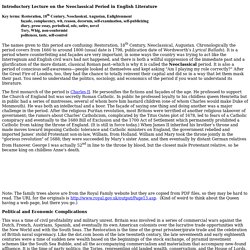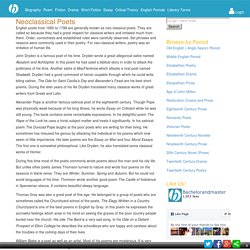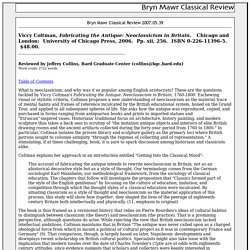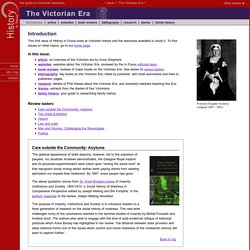

Restoration Literature. In a Nutshell The Restoration is a period in literary history full of humor and hanky-panky.

Shocking, right? We thought dudes that looked like this would be super-uptight. But nope—the most popular writers of the age wrote bawdy comedies packed with sexual innuendo. These writers loved to satirize social manners, sexual codes, and the social classes of their day. What set the literature of this period going was—history time! What's more, the theaters—which had been closed for more than a decade by those uptight Puritans who were in power before Charles II was restored to the throne—were reopened during this time.
But it wasn't just theater that was important during the Restoration age. The Restoration writers were men and women who liked to let their hair down, so to speak (they were actually wearing their hair under wigs). If you're into comedy—and especially stand-up comedy—then you should definitely care about Restoration literature. Why did the hipster burn her mouth? English - English 3805 Restoration and 18th-Century British Literature. Introductory Lecture on the Neoclassical Period in English Literature. Introductory Lecture on the Neoclassical Period in English Literature Key terms: Restoration, 18th Century, Neoclassical, Augustan, Enlightenment façade, complacency, wit, reason, decorum, self-examination, self-publicizing diary, prose essay, periodical, ode, satire, novel Tory, Whig, non-conformist politeness, taste, self-control.

Renaissance & Reformation. Summary The Renaissance began in the cities of Northern Italy, leading to a flowering of art, sculpture and painting.

It also swept into Northern Europe but there the more austere circumstances caused it to focus on religion and literature. The invention of the printing press would also enable new religious ideas to sweep across Europe. Commentary The Renaissance was essentially an urban phenomenon beginning in northern Italy because cities like Florence were less affected by the ravages of the 14th century. As the Renaissance spread to northern Europe, subtle changes occurred, with an emphasis on scientific intellectualism and religious humanism. The word Renaissance means "rebirth", specifically of ancient classical art, a revival of the Greco-Roman culture. They therefore abandoned the architectural and intellectual styles of the Middle Ages, returning to their own indigenous art and philosophy for inspiration.
How Did the Renaissance Change European Culture & Society? Neoclassical Poets. English poets from 1660 to 1798 are generally known as neo-classical poets.

They are called so because they had a great respect for classical writers and imitated much from them. Order, correctness and established rules were carefully observed. Set phrases and reasons were commonly used in their poetry. For neo-classical writers, poetry was an imitation of human life. John Dryden is a famous poet of his time. Alexander Pope is another famous satirical poet of the eighteenth century. During this time most of the poets commonly wrote poems about the man and his city life. Thomas Gray was also a great poet of this age. William Blake is a poet as well as an artist. Robert Burns was a Scottish farmer whose lyrics became famous. Neoclassical Poets. Introductory Lecture on the Neoclassical Period in English Literature.
Bryn Mawr Classical Review 2007.05.39. Bryn Mawr Classical Review 2007.05.39 Viccy Coltman, Fabricating the Antique: Neoclassicism in Britain.

Chicago and London: University of Chicago Press, 2006. Pp. xii, 256. ISBN 0-226-11396-5. $48.00. Reviewed by Jeffrey Collins, Bard Graduate Center (collins@bgc.bard.edu)Word count: 2722 words Table of Contents What is neoclassicism, and why was it so popular among English aristocrats? Coltman explains her approach in an introduction entitled "Getting Into the Classical Mood": This account of fabricating the antique intends to rewrite neoclassicism in Britain, not as an ahistorical decorative style but as a style of thought.
The book is thus framed as a revisionist history that relies on Pierre Bourdieu's ideas of cultural habitus to distinguish between classicism (the theory) and neoclassicism (the practice). Coltman begins her study in the library, which she aptly terms the "backdrop for the aristocracy's intellectual property" (17) and a literary "repository for the antique" (20). History in Focus: The Victorian Era (Introduction) Introduction This first issue of History in Focus looks at Victorian history and the resources available to study it.

The Restoration Period in English Literature: Timeline & Overview. This lesson will explore what is known as the Restoration era of English literature, which lasted from 1660 to about 1688.

We'll look at the context, themes, and styles that define this period of literature. Explore our library of over 10,000 lessons Click "next lesson" whenever you finish a lesson and quiz. Got It You now have full access to our lessons and courses. You're 25% of the way through this course! The first step is always the hardest! Way to go! Congratulations on earning a badge for watching 10 videos but you've only scratched the surface. You've just watched 20 videos and earned a badge for your accomplishment!
You've just earned a badge for watching 50 different lessons.